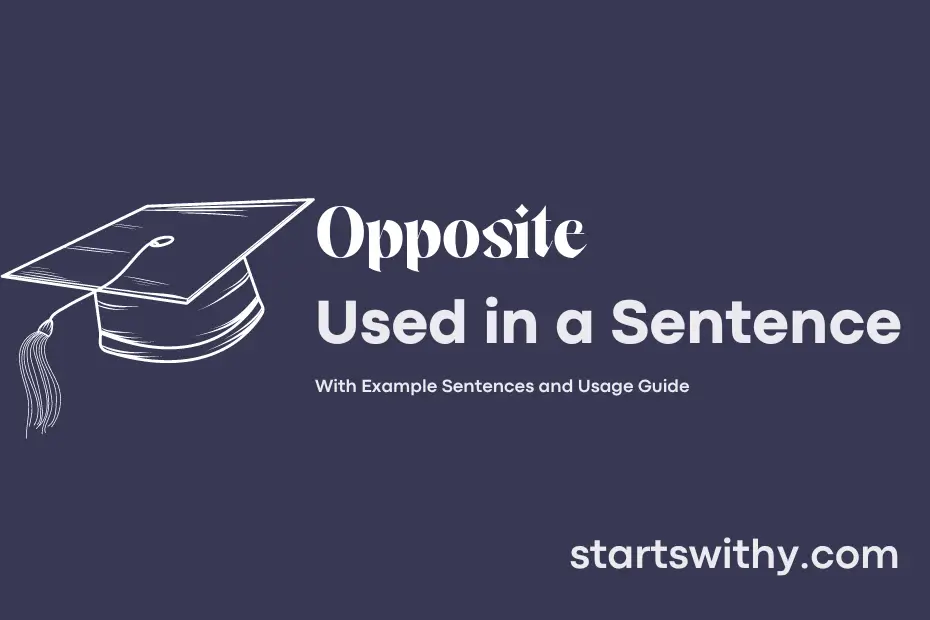When exploring language and communication, understanding the concept of opposites is essential. Opposites are words that convey contrasting meanings or ideas, creating a dynamic relationship that enhances the depth and clarity of communication.
In the English language, opposites play a crucial role in expressing a wide range of concepts and emotions. By using opposite words in sentences, speakers can effectively communicate comparisons, contrasts, and nuances in meaning. Let’s delve into the world of opposites and discover how they shape our language and interactions.
7 Examples Of Opposite Used In a Sentence For Kids
- The opposite of big is small.
- The opposite of hot is cold.
- The opposite of up is down.
- The opposite of fast is slow.
- The opposite of happy is sad.
- The opposite of old is young.
- The opposite of wet is dry.

14 Sentences with Opposite Examples
- Opposite of procrastination is time management.
- Balancing a part-time job and studies requires good time management skills, the opposite of which can lead to burnout.
- In a debate, it is important to understand the opposite viewpoint to strengthen your argument.
- The opposite of success is not failure, but giving up.
- In mathematics, the opposite of addition is subtraction.
- To improve your vocabulary, it’s helpful to learn antonyms, which are words that have opposite meanings.
- Effective communication involves listening as much as speaking, the opposite of which can lead to misunderstandings.
- The opposite of a healthy diet is one filled with junk food and sugary drinks.
- When writing an essay, it’s important to address counterarguments, which represent the opposite perspective.
- Regular exercise is crucial for physical well-being, with the opposite being a sedentary lifestyle.
- In a group project, it’s important to consider the opposite viewpoints of team members to reach a balanced solution.
- The opposite of time management is procrastination, a common challenge for many college students.
- To achieve academic success, it’s essential to prioritize studying over socializing, the opposite of which can lead to poor grades.
- Effective studying involves understanding concepts rather than just memorizing facts, the opposite of which may result in shallow learning.

How To Use Opposite in Sentences?
Opposite is a word used to describe something that is completely different or contrary to something else. Here is a simple guide on how to use it in a sentence:
- Identify the two contrasting things you want to describe.
- For example, “love” and “hate”.
Place the word Opposite before the word that represents the contrasting idea.
- For example: “I feel opposite emotions when I think of love and hate.”
You can also use Opposite before a noun to show how one thing differs from another.
- For example: “Her personality is the opposite of her sister’s.”
Opposite can be used to modify adjectives as well, emphasizing the contrast between two things.
- For example: “His reaction was the opposite of what I expected.”
- Pay attention to the context of your sentence to ensure that using Opposite makes sense in conveying the intended meaning of complete contrast or difference.
By following these simple steps, you can effectively use the word Opposite in a sentence to highlight the differences between two things. Practice using it in various contexts to become more familiar and comfortable with incorporating it into your everyday language.

Conclusion
In conclusion, using sentences with opposite meanings can help convey contrasting ideas effectively. By juxtaposing two contrasting statements, this technique highlights differences, emphasizes points, or creates a sense of balance in writing. For instance, “She was tall, while he was short” illustrates a clear contrast in physical attributes.
Employing sentences with opposite meanings can also add depth and complexity to writing, engaging the reader’s attention and sparking interest. For example, “The room was filled with laughter but her heart was heavy with sorrow” paints a vivid picture of conflicting emotions. Thus, incorporating sentences with opposites can enhance the clarity and impact of communication, making ideas more distinct and resonant for the audience.



